Mississippi Blues Trail Guide: Local Businesses, Restaurants & Can’t-Miss Stops
Driving south from Memphis, down the famous Highway 61 through the Mississippi Delta, the area sure doesn’t look like much – and that’s the way many people have thought of the Delta for years. Although it could be an easy sell for tourists, with its deep music history, the Delta is just as famous for its Mississippi Blues Trail as it is infamous for segregation, poverty, crime and depopulation.
But this trip also showed me how that’s starting to change.
Early one morning, I was out taking photos in downtown Clarksdale, Mississippi (population 14,000). I was blatantly j-walking, but otherwise minding my own business, when an older man slowed down his beat-up truck to yell out the window at me, “Hey! We’re glad you’re here! You have a good day!”
Later that morning, a comment from the director of the local Clarksdale tourism board lended a little clarity to the man’s enthusiasm:
“If you think it looks like a slow day, yeah, it’s a slow day – but 20 years ago, there wasn’t five cars on any of these streets.”
Bubba O’Keefe
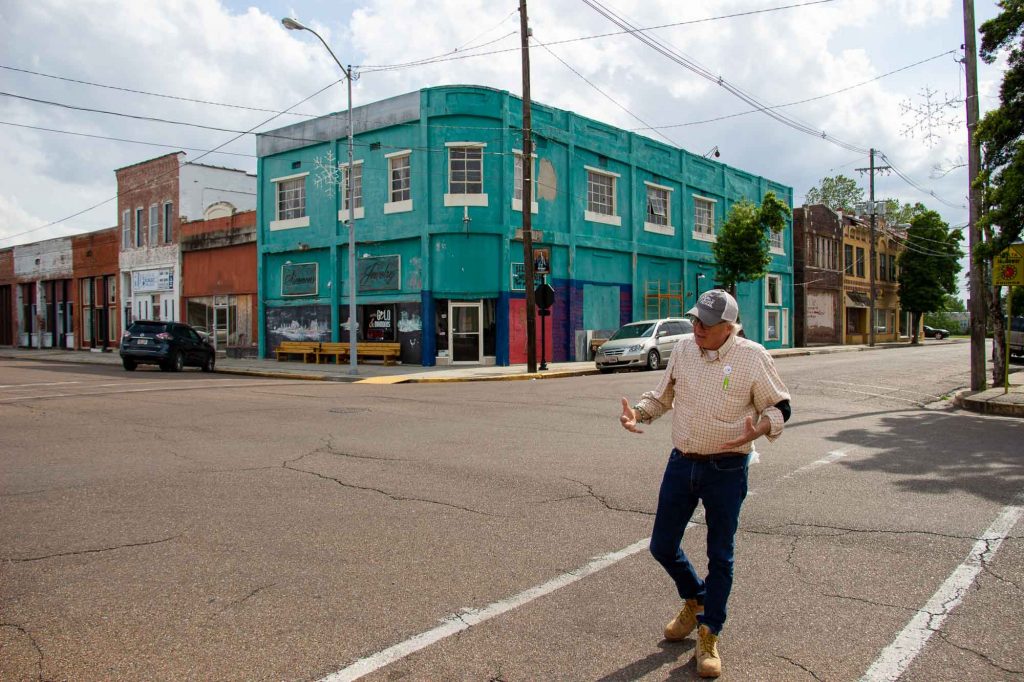
Blues tourism has been a huge part of that development and gradual revitalization in the Mississippi Delta.
And it’s really only been happening since the early 2000’s – with small, locally owned, sustainable businesses leading the way.
Those are the businesses I’m highlighting in this itinerary for a Mississippi Blues Trail road trip (which Clarksdale is the centerpiece of).
[Related Road Trips: Head northeast and enjoy my foodie guide to a sustainable weekend roadtrip in the Adirondacks. Or, if you’re going all the way out West, these are the best organic wineries to visit in Napa Valley.]
Intro to the Mississippi Blues Trail
The official Mississippi Blues Trail stretches from the Mississippi Gulf Coast through every corner of the state. (There are more than 200 official markers – with a few as far away as San Diego, Maine, Spain and Norway.) But the majority of the Blues Trail is concentrated in the Mississippi Delta, in northwestern Mississippi.
As road trips go, it’s about as Americana as Route 66, but much more accessible (more compact – when you leave off the Norway stop, of course), and a bit more under the radar.
Visit Mississippi hosted me on this trip, along with a group of other bloggers and journalists – which meant I didn’t have anything to do with the planning, and started out with absolutely no idea where I was going. But I ended up finding more than just music and history along the Trail.
This was a whirlwind itinerary to pack into just two days on the Mississippi Blues Trail. We started in Memphis, and stopped in the towns of Tunica, Clarksdale, Cleveland, Indianola, and Tupelo, Mississippi.
The first four towns are each less than 40 miles from each other, so this itinerary is definitely doable in 48 hours – but I’d recommend stretching it out to at least three full days.
I’ve included advice for what I would cut out, what I would add, and where I’d spend a little more time soaking up the Blues.
In short: My favorite parts of this trip were the town of Clarksdale and the BB King Museum in Indianola. The next time I go back to the Delta, I’d like to slow it down, and add the town of Greenwood. And if you’re an Elvis fan, you can’t miss Tupelo.
Logistics: Memphis is a logical starting point for this trip, with a major airport just about an hour away from Tunica, but you could also do this road trip in reverse, starting from Jackson, Mississippi, or New Orleans (the other airport hubs in the region).
(I’m working with a new map system to add to my posts! I hope you find it useful. Click the legend to show or hide categories, and read on for details on all these spots and more!)
Tunica, Mississippi & the Gateway to the Blues
Our first stop was the Gateway to the Blues Museum, near the town of Tunica, Mississippi. (Just 40 miles from Memphis.)
Tunica is known today as a gambling destination, but before the state legalized gambling in 1992, the whole of Tunica County had just one stop-light.
The iconic museum is housed in an old, tin-roofed train depot, which was moved from Dundee, Mississippi (25 miles down the road) after the trains stopped rolling.
As the museum explained, those trains were a big part of how the Blues spread from Mississippi to Chicago.
Railroads & Blues History
Tunica, Clarksdale and Cleveland all used to be connected by passenger rail lines, which now sit abandoned. (And several of the museums on this route are in former train stations.)
Those routes were how early Blues musicians got around to their gigs and to learn from each other. The majority of them were Black sharecroppers, many of whom grew up picking cotton on plantations, and living under the oppression of Jim Crow – so they certainly weren’t wealthy enough to own vehicles.
That got me thinking about something that was on my mind throughout the trip: The role of trains in the history of the Mississippi Delta, and of accessible transportation as a way – literally – out of poverty.
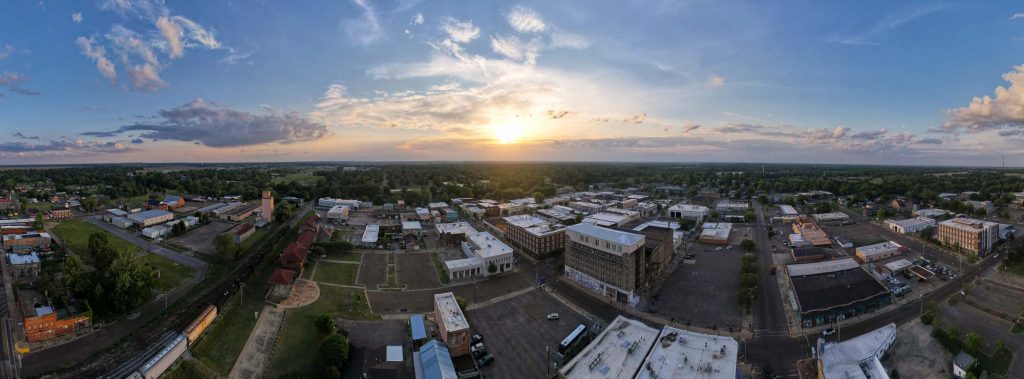

And there’s very little public transportation in the Delta today, which is one of the country’s poorest regions by just about every quantifiable statistic.
But as the manager of a local coffeeshop and youth arts program told me:
“It’s the things that are hard to quantify that make the Delta special. It’s the history, the culture, the creativity.”
Ben Lewis, Griot Arts
The Gateway to the Blues Museum
The museum makes a great photo opp., and has fun interactive elements (like a booth where you can record your own blues song, and instruments you can play).
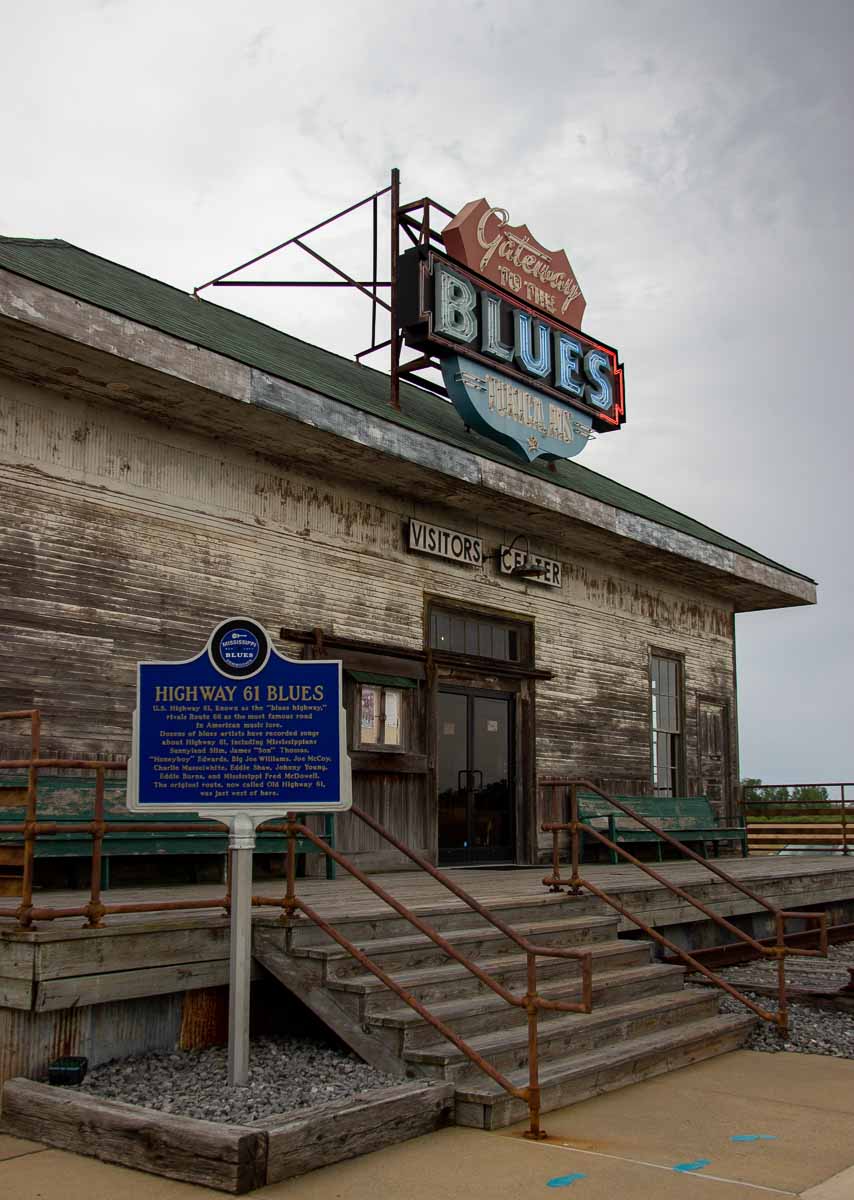
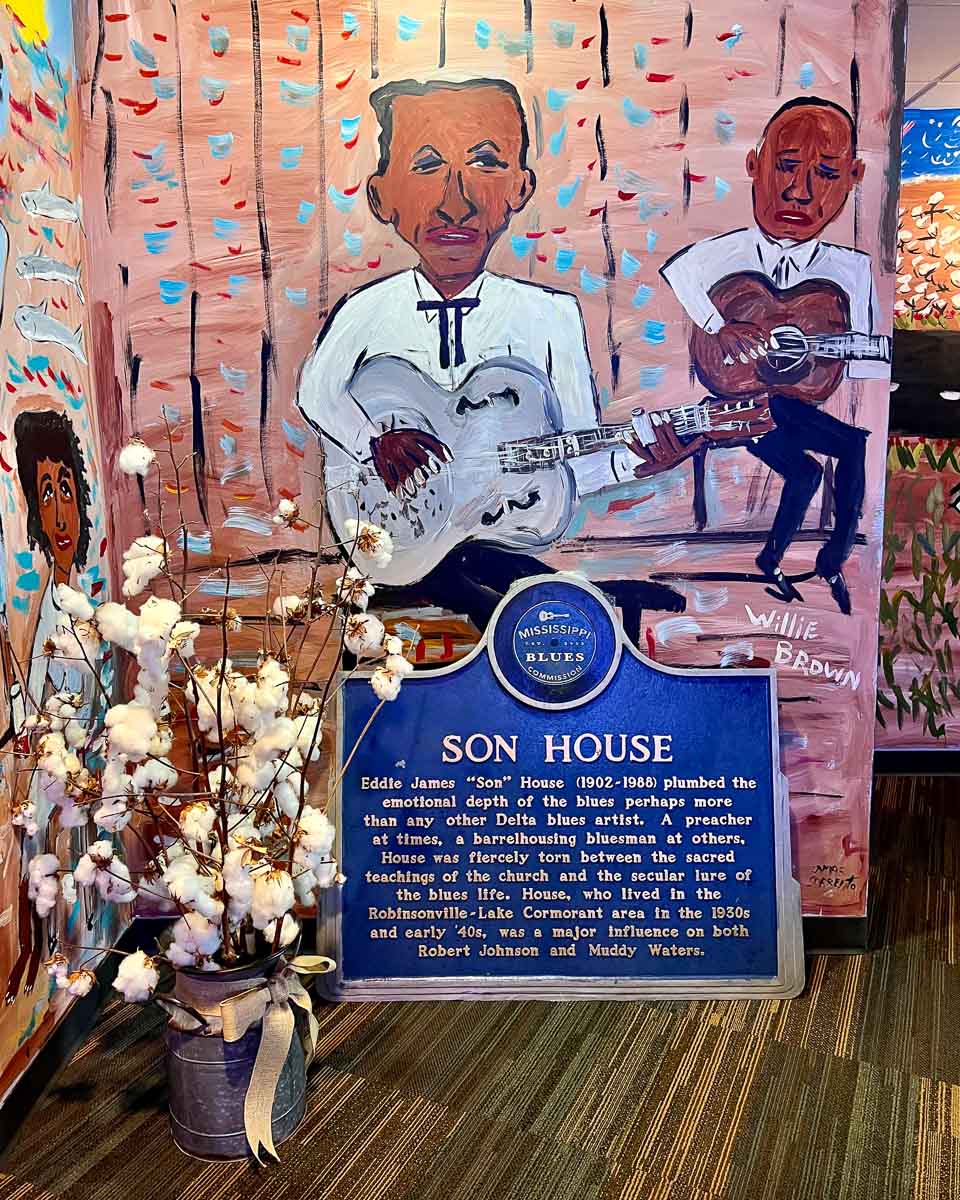
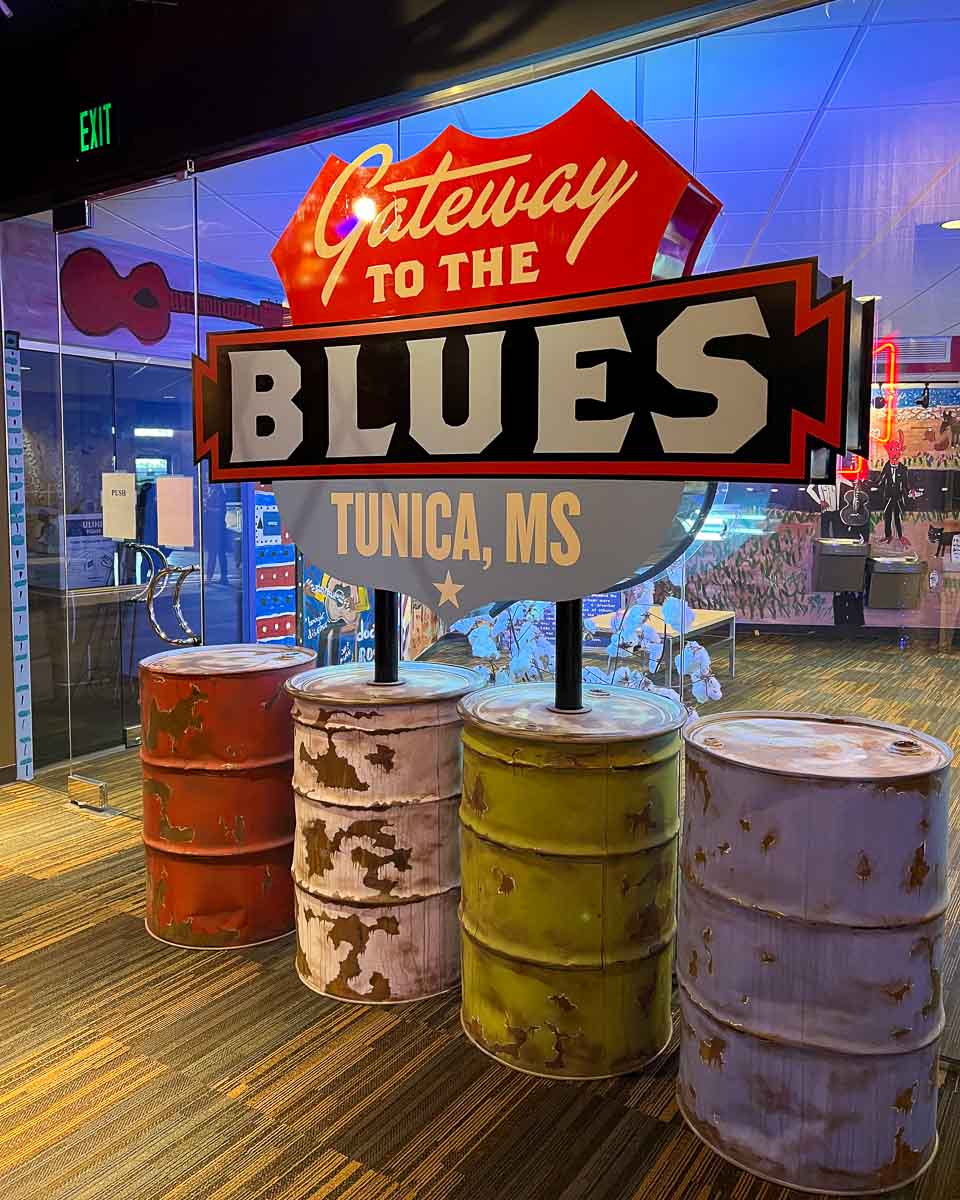
As an intro to the trip, this is worth a stop between Memphis and Clarksdale. But honestly, the Gateway to the Blues Museum was not my favorite music museum on this tour.
A few of the signs felt a bit cringe-worthy, with language about “procuring slaves,” for example. (Uhhh, you mean kidnapping people?) The museum originally opened in 1996, and I would bet that the displays haven’t been updated much since then.
In a place like the Mississippi Delta, where the main attraction – Blues culture – is literally the fruit of the subjugation and suffering of Black people, language like that always makes me worry whether those people have a role in telling the region’s story, even today.
Otherwise, the information in the museum is extremely thorough, and gives a great overview of the origins of the genre. Perfect for the beginning of your trip down the Blues Trail.
Tip: There’s quite a collection of small museums on the Mississippi Blues Trail, with a lot of overlap in the content. So if you’re limited on time, don’t feel the need to stop at all of them – unless you’re a diehard fan.
Buy ahead: Tickets for the Gateway to the Blues Museum
Clarksdale, Mississippi: “Ground Zero of the Blues”
The next stop on this route was my favorite town of this Delta Blues trip – Clarksdale, Mississippi.
Clarksdale is famous for having live Blues performed in one of the town’s many small venues every single night of the year, plus more than a dozen annual music festivals.
(Some of the major festivals in town are the Juke Joint Festival in April, the Sunflower River Blues & Gospel Festival in August and the Deep Blues Fest in October.)
(It’s also famous for being home to musicians including Muddy Waters, Sam Cooke, Ike Turner, and Rick Ross.)
But – as someone who knew hardly anything about the Blues before this trip – I can tell you that there’s much more than music to enjoy here.
For such a small town, Clarksdale is impressively full of grit, culture and history – and it’s in the middle of a fascinating small-town renaissance.
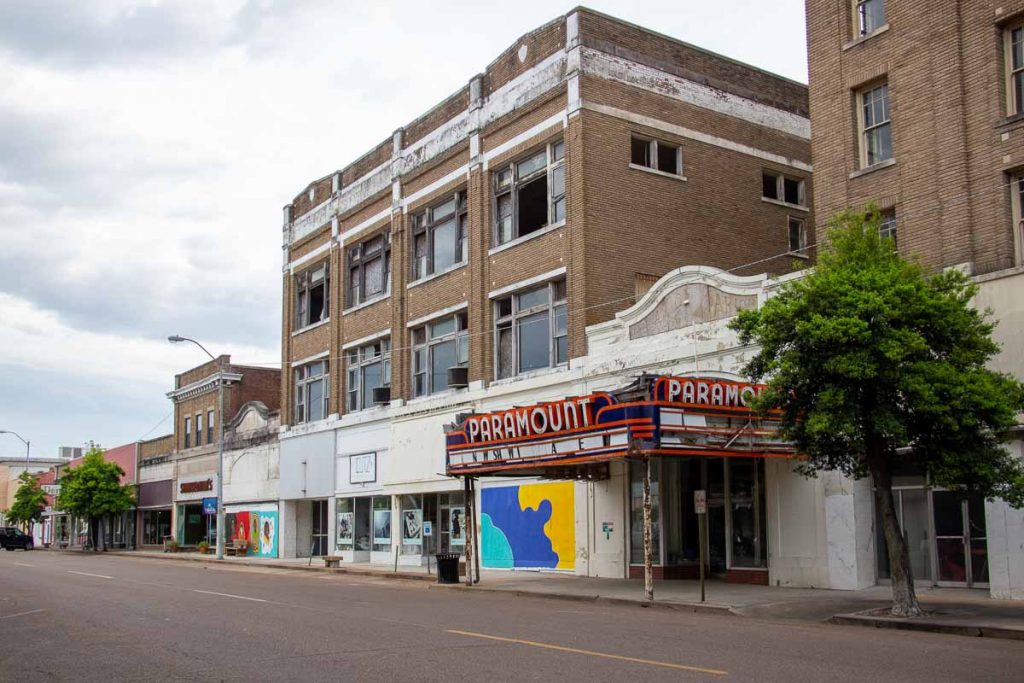
Clarksdale is also home to my favorite hotel, my favorite restaurant and the most vibrant mood I found on this entire trip. Read on for an itinerary and must-see spots in Ground Zero of the Blues.
Clarksdale Restaurants & Entertainment:
For dinner, head to Hooker Grocer & Eatery for Southern classics with fresh, high-quality ingredients and excellent cocktails. I ordered grilled catfish and grits, and it was the best meal I ate during my week in Memphis and Mississippi.
For after dinner entertainment, check the town’s weekly live music schedule. I went to Bluesberry Café for a concert under the stars in an alley.
Ground Zero Blues Club is an absolute must-see in Clarksdale. The club is co-owned by Morgan Freeman, and is a Blues institution.
We listened to a local artist named Super Chikan who gave a thoroughly entertaining performance at Ground Zero. Listen to a glimpse of it in my Instagram reel below:
Red’s Lounge is another spot I’d love to go back for – it’s one of the oldest juke joints that’s still running. Cash only and no videos allowed.
Finally, Messengers is a café, bar and pool hall that’s the oldest Black-owned business in Clarksdale. (Opened in 1907, and now run by a fourth generation of the Messenger family.)
For breakfast in the morning, Our Grandma’s House of Pancakes serves up pancakes for (not kidding) $1 each. The coffee isn’t what I’d call third-wave coffeeshop gourmet, but the food is fresh and excellent, and the place feels like a true small-town classic.
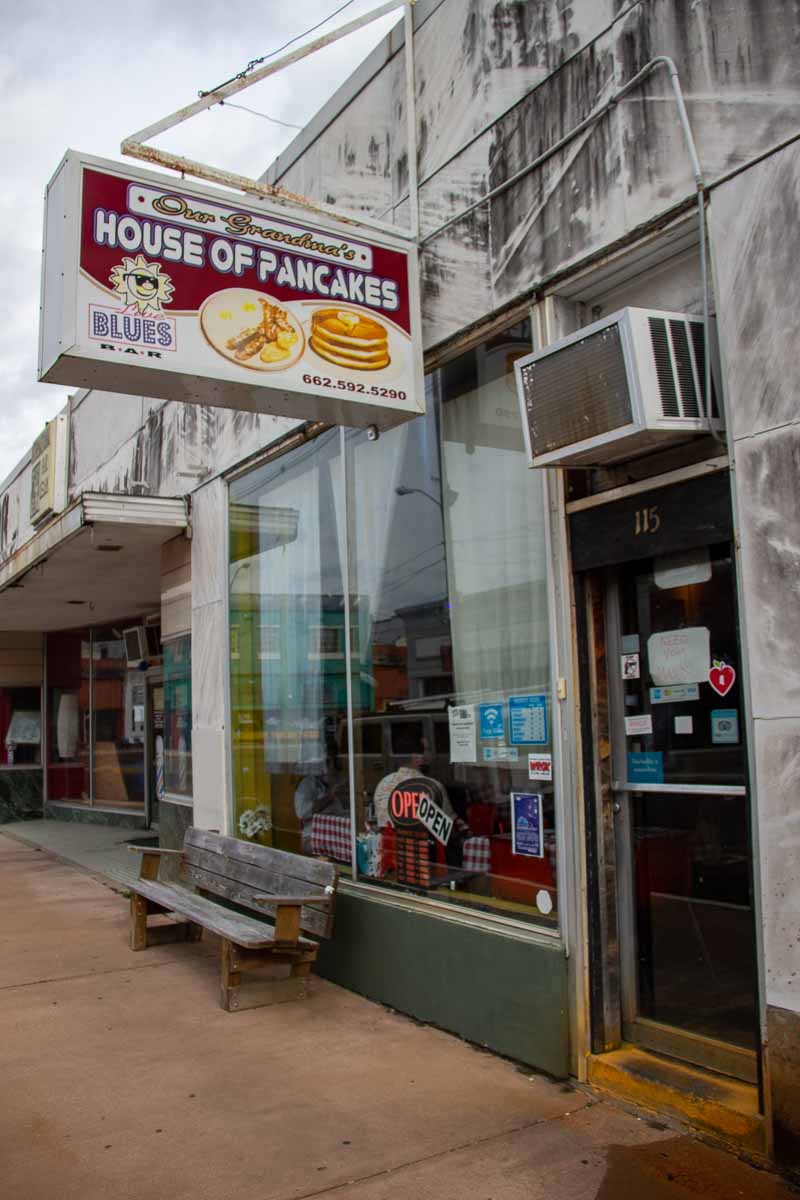
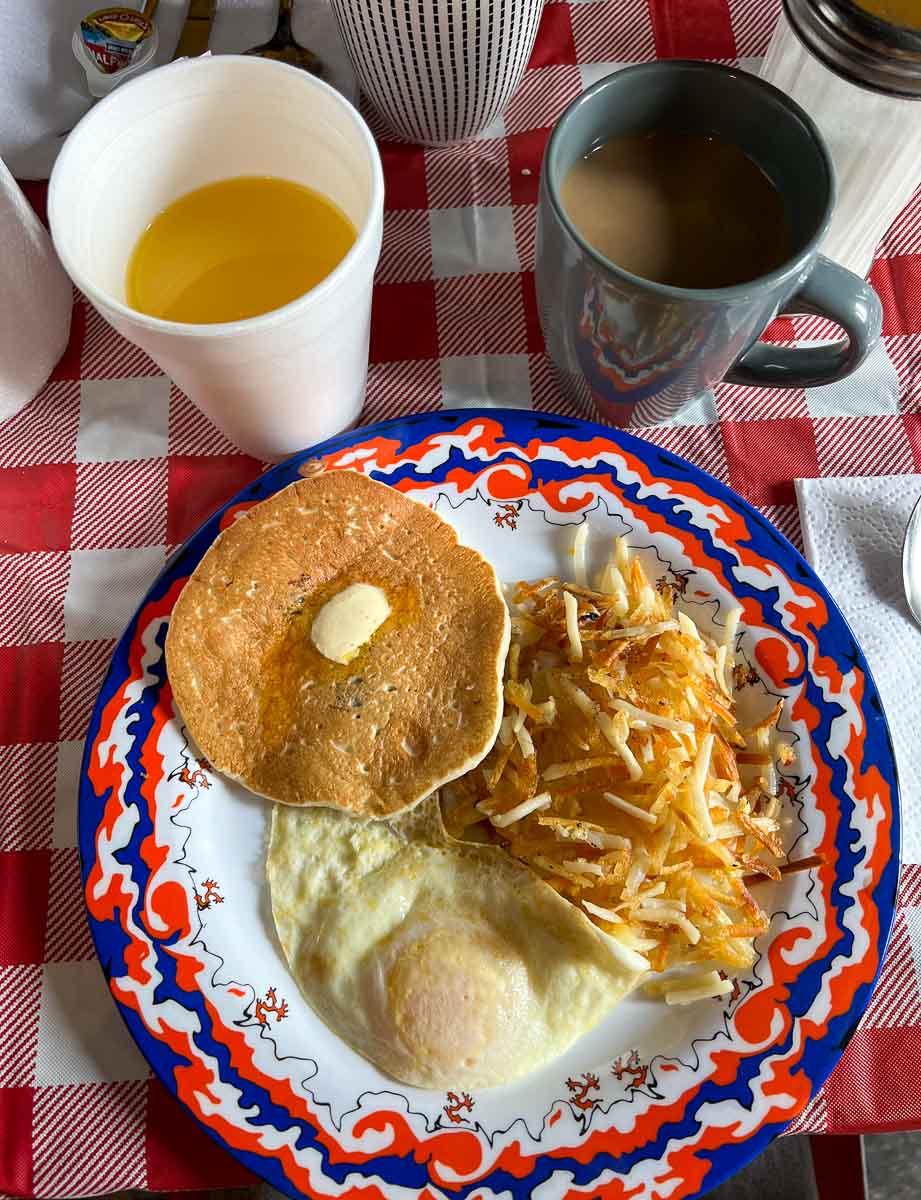
Yazoo Yaupon “Tea” – A Unique Local Drink
Yaupon isn’t really tea, but it’s the only plant native to North America that contains caffeine. It doesn’t have the tannins of normal tea, or the potential for bitterness if it’s not brewed correctly.
Yaupon is endemic to the Southeast, and indigenous people have been drinking it for thousands of years. Now, a new small business in Clarksdale, Yazoo Yaupon is bringing it back.
I tried a cup of peach-flavored yaupon at Meraki Roasting Company. It tastes a lot like a standard, Southern peach tea, but has such a unique, local and sustainable flair.
(The coffee shop, which is excellent, is also a job training program, run by the non-profit youth program Griot Arts.)
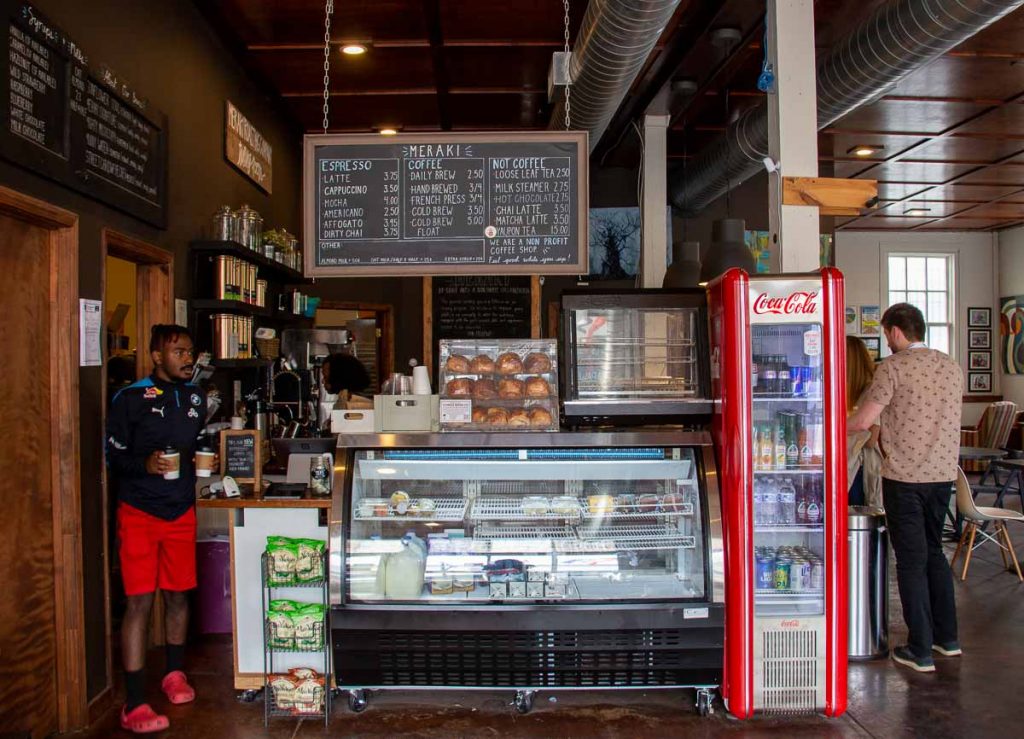
What Else to See in Clarksdale:
The Delta Blues Museum is the one spot in Clarksdale where tour busses used to stop on their way from Memphis to Jackson or New Orleans. Ironically, there’s now so much else to do in Clarksdale that we didn’t even have time for it.
Since it’s Mississippi’s first music museum, and the first museum dedicated exclusively to the Blues, I’d definitely go back for it. (It’s also the current location of the shack where Muddy Waters grew up, among other items of local Blues history.)
For a dose of history, stop by the Carnegie Public Library to see local historical photos in the Mississippi Room.
Built in 1911, the library was completely segregated – Black people couldn’t use any part of it until they petitioned for access in 1929. But instead of integrating, the library built a separate Myrtle Hall Library for Negroes in 1930, and the main library wasn’t integrated until 1970.
Cat Head is a can’t-miss stop in Clarksdale: It’s a music store, gift shop, photo gallery of Blues history, and driving force in the organization of the local music scene.
That’s all because of the expertise of the owner, Roger Stolle, who opened the store in 2002, and immediately got to work interviewing many of the great Bluesmen. I’m sure if you have questions about the Blues or local history, dropping by Cat Head to ask Roger would be a sure way to get them answered.
Plan Ahead: Cat Head’s website (which is a blast from the past in terms of web design) also has the only comprehensive schedule of ALL of Clarksdale’s music in one place. (From daily shows to annual festivals.)
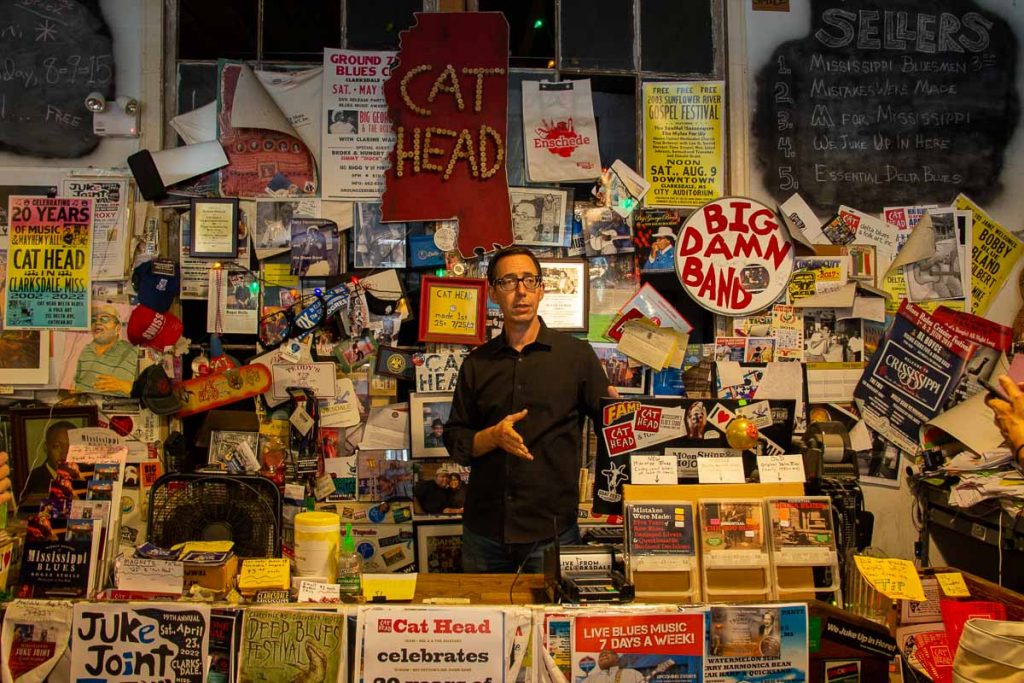
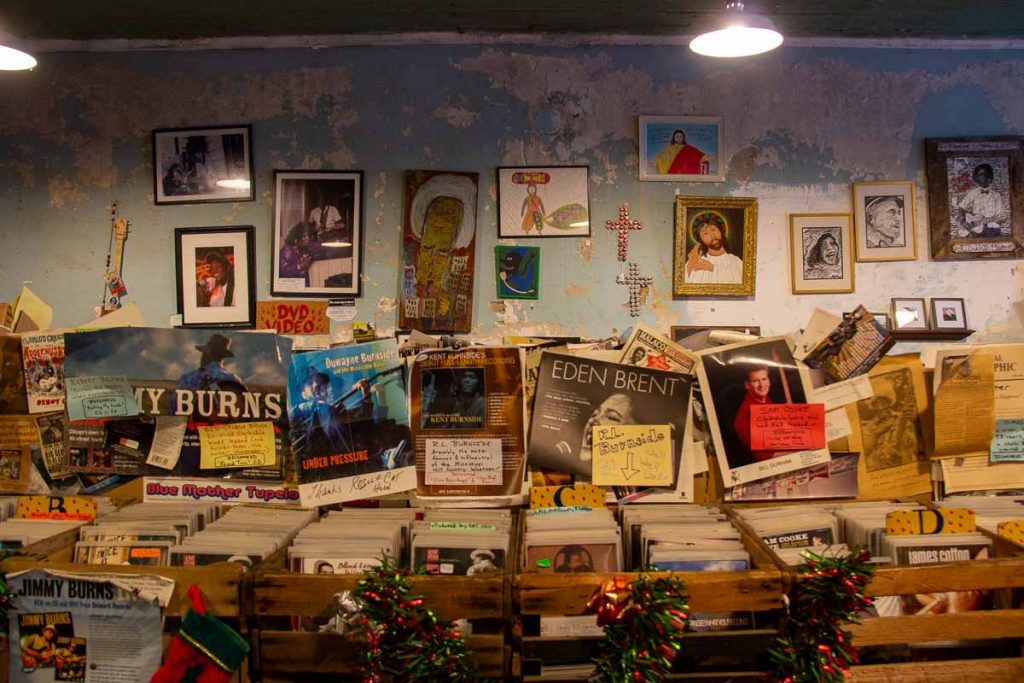
The Most Famous Crossroads in Blues Lore
Finally, just a few blocks from downtown, at an otherwise unimpressive intersection, you’ll find three important things: First and most obvious is the famous intersection sign marking Highways 61 and 49 – site of the most famous story in the Blues: Robert Johnson selling his soul to the devil in exchange for his legendary musical skills.
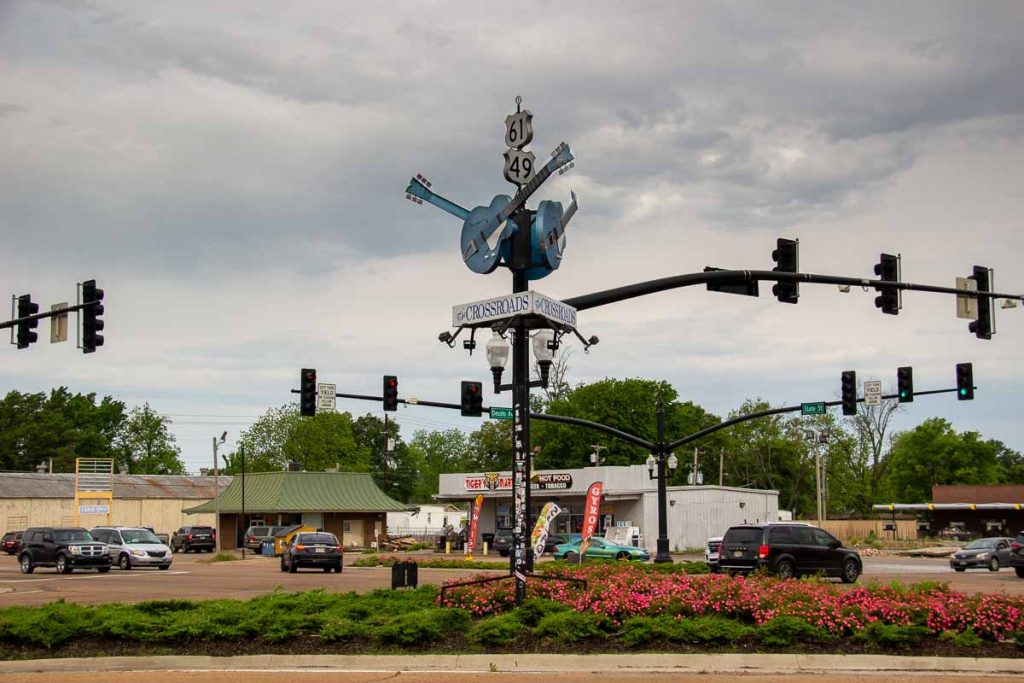
Johnson died at age 27 and only ever recorded 29 songs. One of them, Crossroad Blues, is supposedly about this very spot. (Listen below:)
There’s a stone monument to the story near the intersection, and behind the monument is Abe’s BBQ. As the story goes, while Robert Johnson was convening with the devil to acquire his Blues skills, Abe was praying to Jesus for his BBQ sauce recipe.
When I stopped by, Abe’s neon “open” sign was already illuminated, impressively, at 9:15 in the morning.
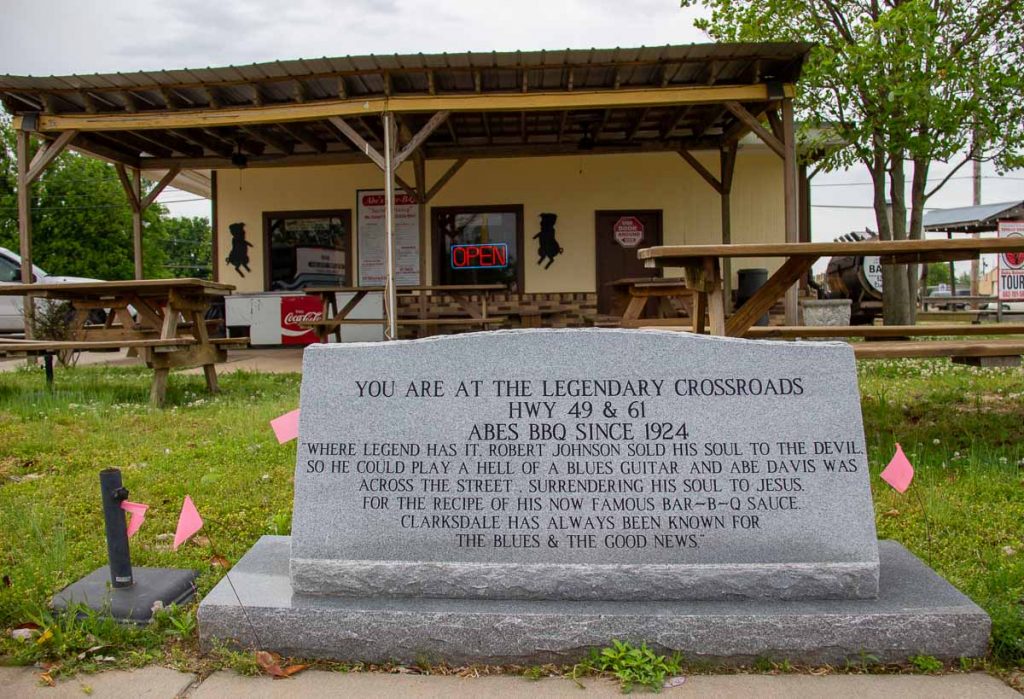
Get on the River!
For something totally different, Clarksdale is also becoming well-known as the starting point for guided tours down the Mississippi in hand-made wooden canoes.
This is the adventure I really want to go back to the Delta for, and I’d happily spend a couple of nights in Clarksdale again at the beginning and end of the trip.
Where to Stay in Clarksdale:
If you want to make one town your home base for your Mississippi Blues road trip, I’d definitely make it Clarksdale, since it has so many unique and historic hotels to choose from. These are my favorites:
- Travelers Hotel – This is where we stayed in Clarksdale, and it’s one of my favorite hotels ever. Glamorous and modern with a social mission, this 20-room hotel funds a local artists’ residence.
The local owners, Chuck and Ann, also have a sister hotel in New Orleans, where they lived for 20 years.
And I think that’s one of the biggest messages of the rejuvenating effect that tourism can have in small communities like Clarksdale: Chuck grew up in Clarksdale, and the couple moved back to town to start the Travelers Hotel. In a region battling depopulation, tourists’ interest in local culture is creating jobs and enticing former residents to come back.
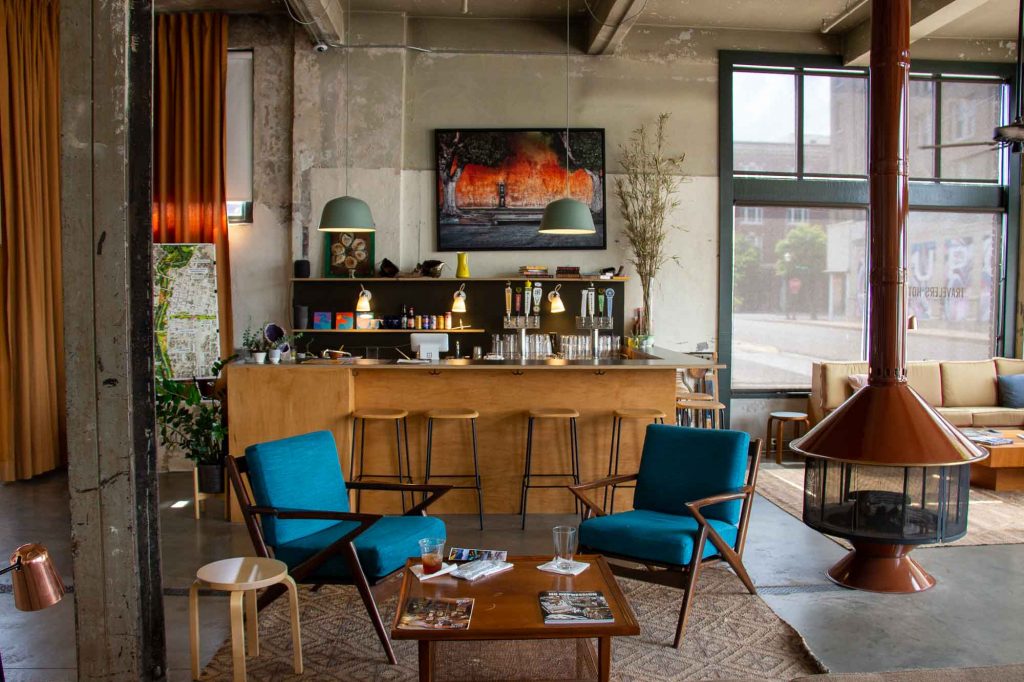
The historic building housed railroad workers before World War Two. At that time, each room just had a sink, with shared bathrooms down the hall. The hip interior design, with concrete floors and oversized art, could almost make it a hotel in London or San Francisco, but it still feels uniquely warm, historic and just really well done.
The ceilings in the rooms tower at 11 ½ feet. And the walls retain a gorgeous, fresco-like blue and yellow splotchiness – the mark of 30 years of vacancy before the building’s renovation in 2018. Both of those elements made the Travelers Hotel remind me of Italy – far more than I expected to be reminded in Mississippi.
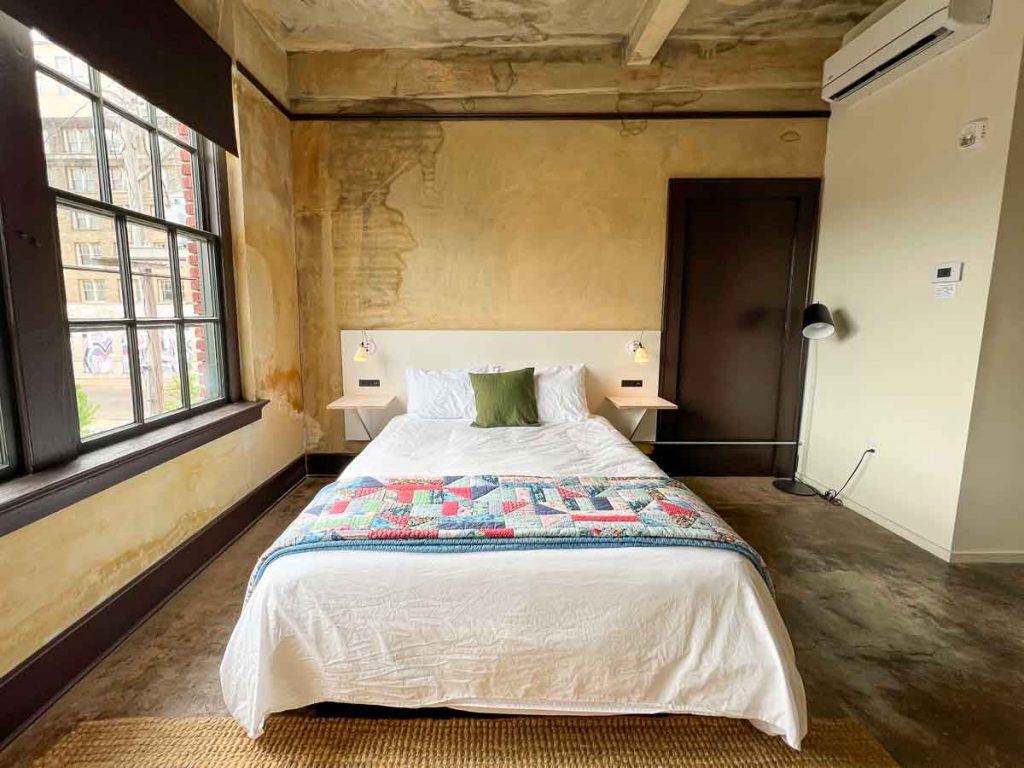
Plus, the Travelers passes the first two sustainability tests I always look for in hotels: Refillable toiletries (instead of individual plastic ones) and AC that wasn’t cranked down to winter-like temperatures for check-in.
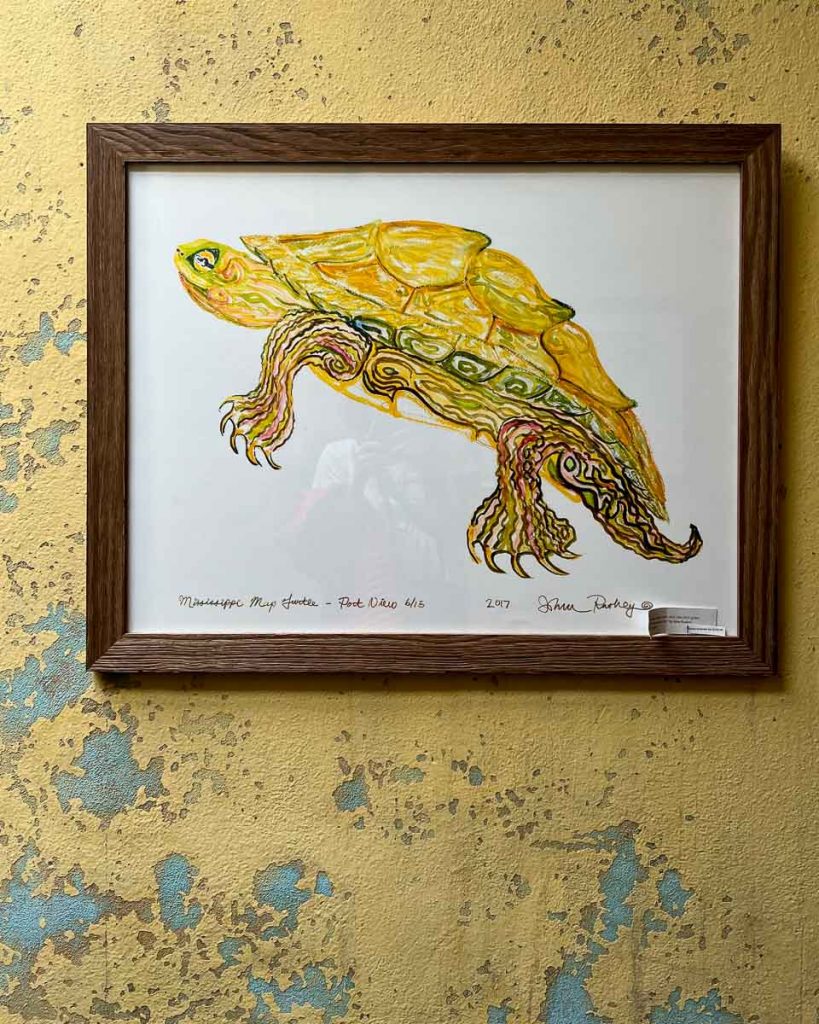
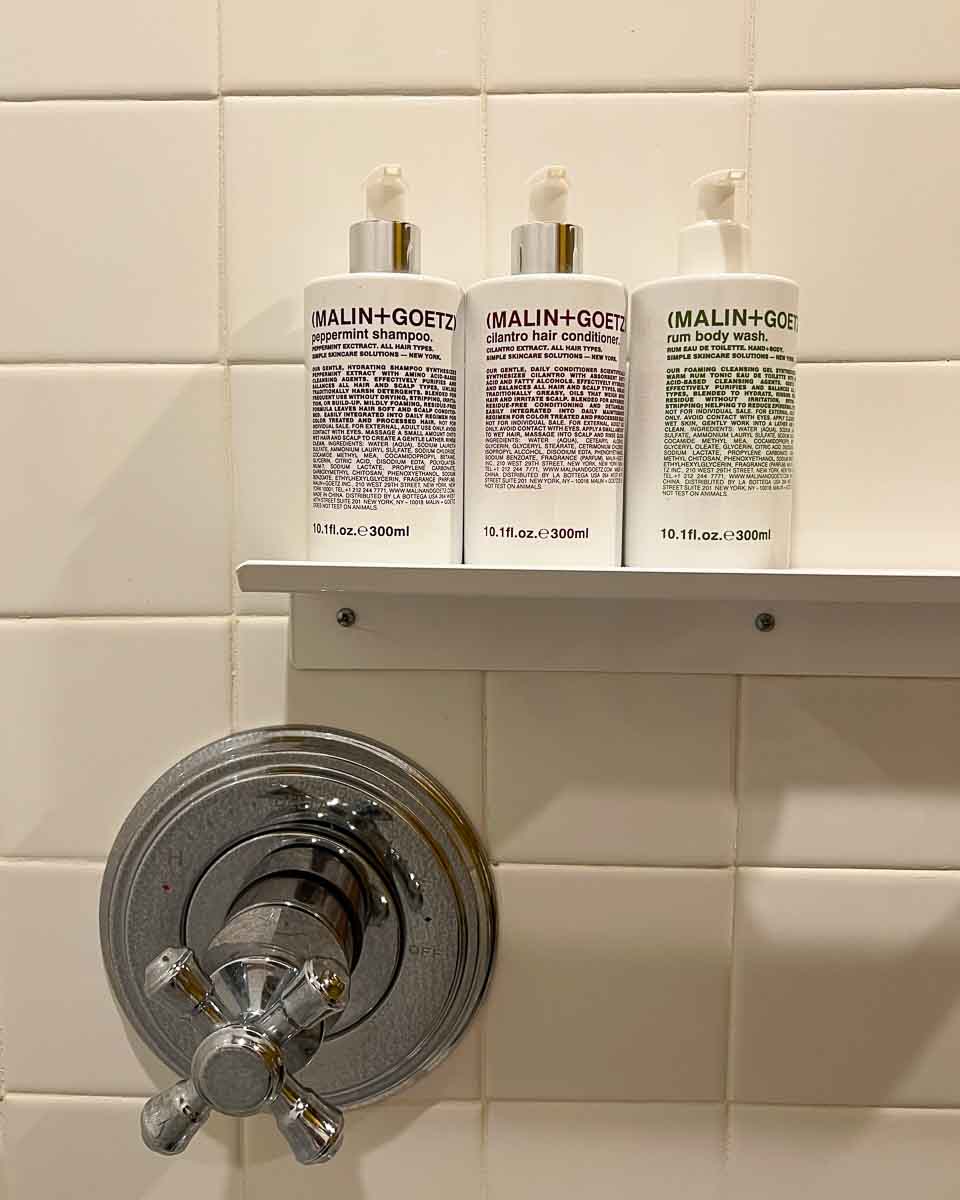
(To always pack your own sustainable, plastic-free toiletries, check out the list of products I actually use!)
More Top Clarksdale Hotels:
Like the Travelers Hotel, these hotels are all locally owned businesses.
- Riverside Hotel – This was a former “Afro-American Hospital” where Blues singer Bessie Smith died after a car accident in 1937. Then, in 1944, a Black businesswoman named Mrs. Z.L. Ratliff Hill transformed it into a hotel – and it’s still run by her granddaughters today. Along with being listed in the Green Book, the Riverside Hotel has hosted numerous R&B and Blues legends. (Including Duke Ellington, Muddy Waters, Howlin’ Wolf, and Sam Cooke. A few even moved in full-time.) This is a place you choose for its history, not for a luxe accommodation.
- As of writing (May 2022), the Riverside isn’t currently open for guests because of damage from a fallen tree. But one of the owners, Zee, still says to stop by for a chat when she’s hanging out on the front porch.
- The Shack Up Inn – These funky, historic shotgun houses (sharecroppers’ homes, which are now an emblem of the South) have been moved to a spot by the side of Highway 61 and redone inside. “Shacks” with one to three bedrooms go for $80 to $250/ night – but the inn doesn’t allow children (or anyone under 25). It has… let’s just say, a strong personality, as you can see from their FAQ page.
- The Lofts At The Five And Dime – A newly renovated, stylish boutique hotel downtown with suites that accommodate several guests for around $150/night.
- The Auberge Clarksdale Hostel – the first and, so far, only hostel in Mississippi, right in downtown Clarksdale! This definitely looks like a nice place, and at $35/ night for a dorm room, the price can’t be beat. (They have private rooms for two to four people at around $95/night.)
- Just like the Travelers Hotel, the Auberge also has a location in New Orleans. You can book either on Hostelworld.com, if you prefer.
Compare other Clarksdale hotel rates on Booking.com.
(Related: Check out my favorite creative alternatives to AirBnb – including several sustainable and community-focused accommodation options.)
Next stop from Clarksdale:
If you’re in a hurry and want to see Elvis’ hometown, head East to Tupelo, a two-hour drive. (Graceland also offers a group day-trip from Memphis to Tupelo for the Elvis fans.)
Otherwise, keep going South, and it’s just an hour to Indianola, passing through Cleveland, Mississippi.
Cleveland, Mississippi & The Grammy Museum
Did you know the state of Mississippi can claim more Grammy winners per capita than any other state?
In theory, that’s why the only official Grammy Museum outside of Los Angeles is located here.
This is the place to go if you’re interested in diving into the state’s music scene that goes beyond the Blues.
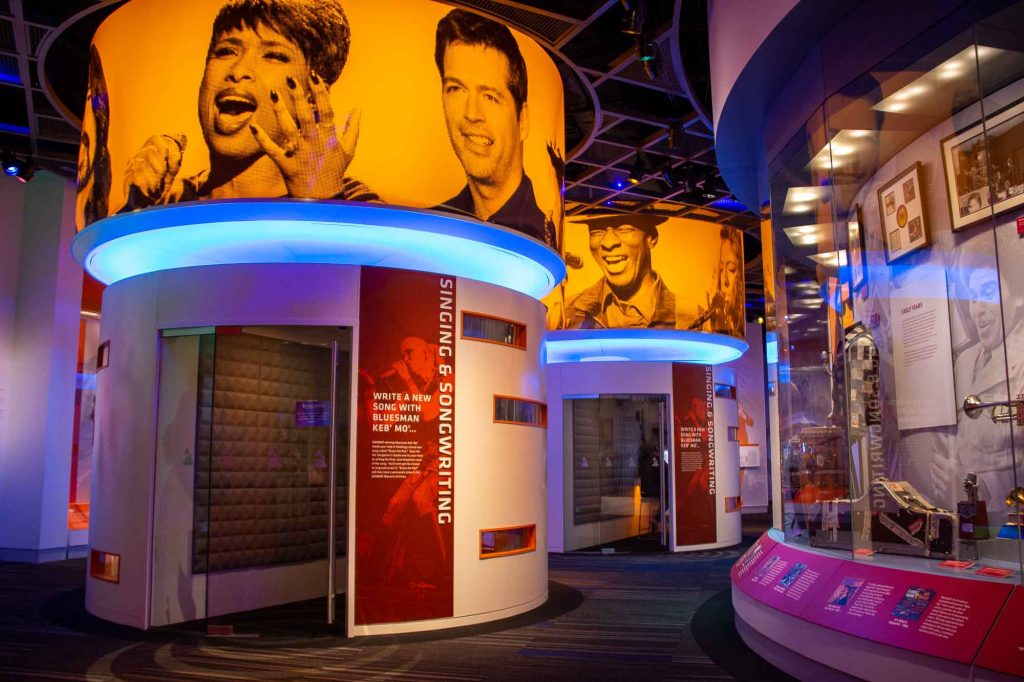
Cleveland is right at the center of what’s known as the Americana Music Triangle. It’s a much bigger commitment in terms of road trip routes – encompassing everything on the Mississippi Blues Trail, plus a lot more covering nine musical genres between Nashville, Memphis and New Orleans.
If you’re a music lover, the Grammy Museum Mississippi is worth a stop. It’s very interactive, modern, and (hey, for me this is a selling point) colorful. A recording booth lets you sing along with five-time Grammy-winner Keb’ Mo’ to create your own Blues song. And there’s a light-up dance floor where Ne-Yo shows you just how incompetent you’ll be when you try to follow his moves.
Buy ahead: Tickets to Grammy Museum Mississippi
For lunch, we stopped at Cleveland’s Airport Grocery, which I can only describe as Southern country kitsch to the extreme.
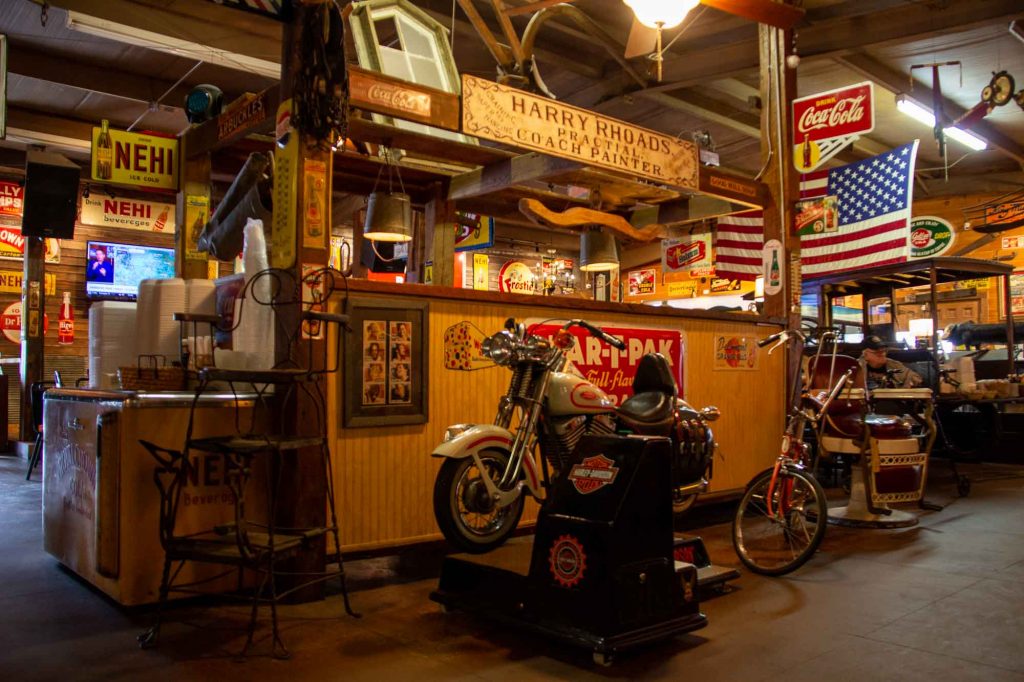
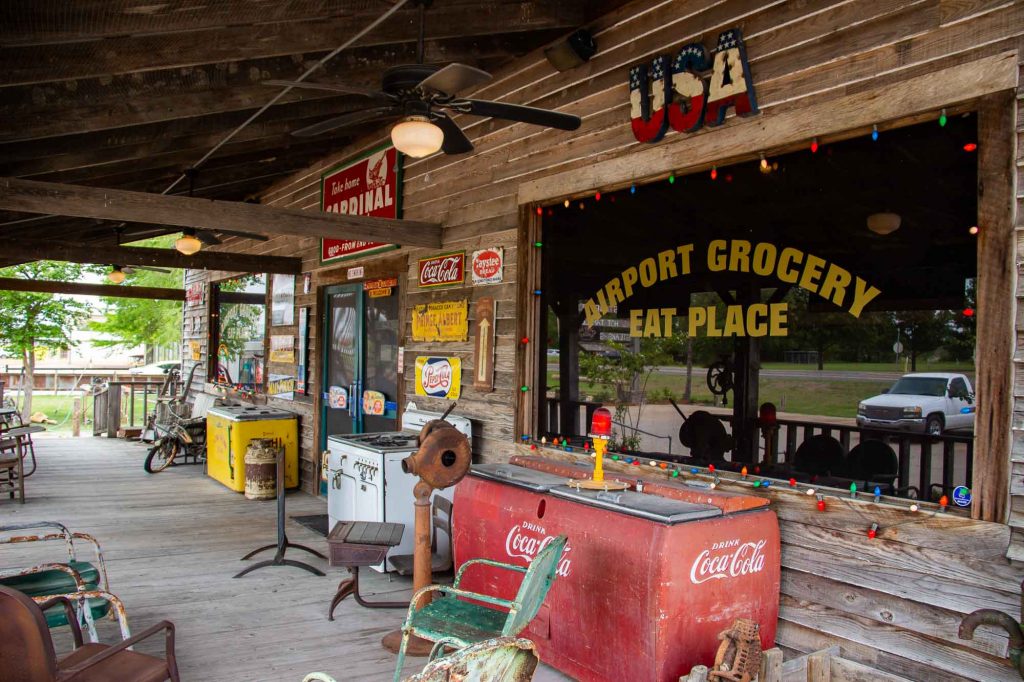
It’s a fun stop for some photos and soul food staples: Fried pickles, fried okra (really, fried just-about-everything), and, my favorite, tamales. (Which Anthony Bourdain even called, “about as Mississippi as they are Mexican.”)
But in my opinion, Airport Grocery is more about the ambiance than the food, so I wouldn’t put it on your foodie travel list for the cuisine alone.
What Else to Do in Cleveland, Mississippi:
Dockery Farms is a cotton farm known as the “birthplace of the Blues.” (Even BB King says so.) That’s mostly because Charley Patton, AKA “the father of the Blues,” grew up working the fields there – and learned to play guitar there.
Howlin’ Wolf and other Blues greats also lived at Dockery at various times.
The farm was 10s of thousands of acres, and had its own town, railroad and currency. The owner, Will Dockery, was known for paying good wages, and the farm is still in operation by three of his granddaughters today.
Po’ Monkey’s Lounge was an original, rural juke joint that I’d love to go back in time to see. Unfortunately, it closed when the owner died in 2016. But it’s still a stop on the official Mississippi Blues Trail, and I think it would still make an excellent backroad detour, just 8 miles north of Cleveland, Mississippi.
Cleveland is also home to Delta State University, which is why it has a lively downtown area that never became as abandoned as Clarksdale’s downtown once was.
Indianola, Mississippi & the (excellent) BB King Museum
If you only have the time (or interest) to take in one music museum on the entire Blues Trail, I think you should make it the BB King Museum and Delta Interpretive Center. In my opinion, it was the most comprehensive and professional of all the museums we visited. (BB King’s grave is also on the museum grounds.)
This museum doesn’t shy away from the reality of growing up Black in the south, especially in BB’s time.
More than any of the other museums we visited, it dives into race relations and civil rights history. But it does so with a refreshingly positive lens that focuses on the solutions, not the demons.
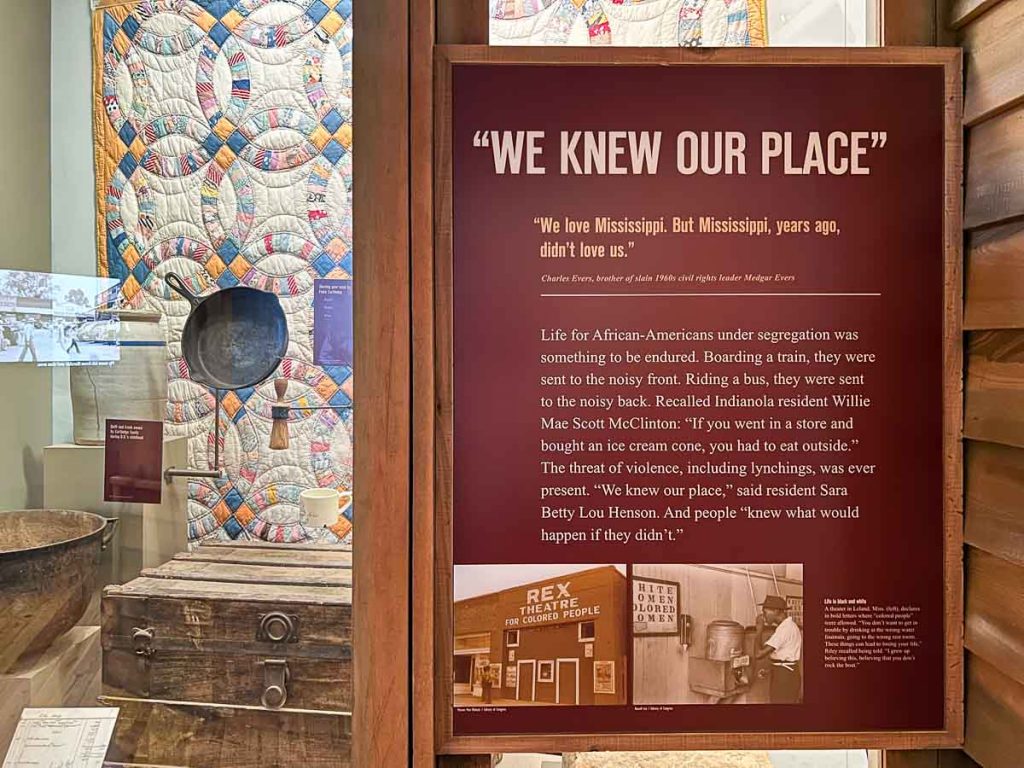
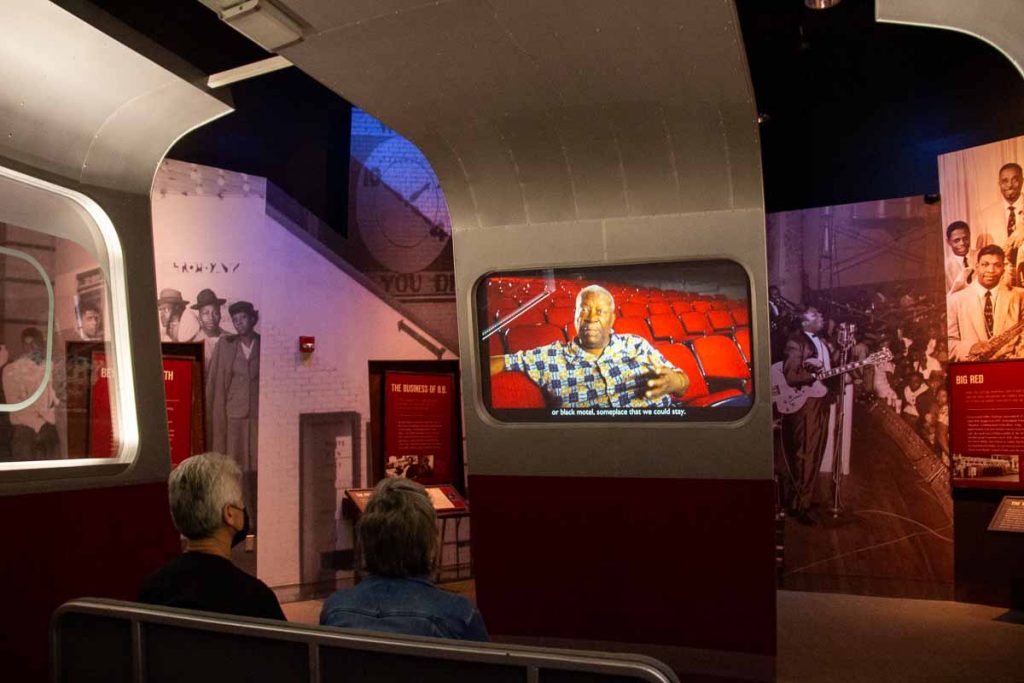
Early in the exhibit, we learn that BB grew up working on a farm for a white family. He was friends with their son, and the family helped him buy his first guitar. BB said that’s where he learned to judge people by their actions, not by their skin color.
That philosophy carried through the entire museum beautifully.
It doesn’t seem possible to buy tickets to the BB King Museum ahead of time, but hours and pricing info are here.
The museum also now owns the historic Club Ebony. The club is one of the most famous juke joints in Mississippi, and BB King owned it for a time to ensure its preservation. It’s only open for special events.
Greenwood, Mississippi
I asked both of our tour guides where they wished they’d had time to take us on this trip, and they both said Greenwood. (And I asked them separately! Double-blind test!)
In terms of Blues history, Greenwood is known as the mostly likely gravesite of Robert Johnson, at the Little Zion Church. (Although there’s still some lingering uncertainty over this, but all three potential locations are near Greenwood.)
But you could also add Greenwood to your road trip itinerary if you’re looking for something that’s not Blues-related.
One such option is the independent Alluvian Hotel and Spa, which is known as an upscale local getaway. It’s famous and has won numerous awards, however, recent reviews on TripAdvisor were quite mixed, so I’m not sure if this is a faded-glory kind of place.
But the cooking classes at the Viking Cooking School across the street seem more universally loved. (Yes, fun fact: The famous, super-upscale Viking brand ranges are made in Greenwood, Mississippi.)
Next Stops After Greenwood:
If you want to keep this trip short, I would end the trip in Greenwood. The town is the half-way point between either of the major starting points for this trip. (It’s roughly a 2-hour drive or train ride from here up to Memphis, Tennessee, or down to Jackson, Mississippi.)
(Greenwood has one of just a handful of trains stations left on Mississippi’s two remaining passenger train lines. The town of Marks is the other stop that could be useful for this trip. It’s closer to Clarksburg.)
But if you’re a true Blues fan, or if you’re just having too much fun on this road trip, there are three more towns you could easily stop by for even more of the Mississippi Blues Trail: Bentonia, Meridian, and West Point.
I haven’t been to any of them, but they all have some serious Blues history, and the itinerary would make a perfect circle back North to Tupelo and Memphis.
Bentonia & the Blue Front Café
About 70 miles south of Greenwood, Bentonia is a tiny town (population: 319, according to Google) that’s known for its Blue Front Café – the oldest juke joint in Mississippi. It’s an active music venue, run by hometown Blues legend Jimmy “Duck” Holmes.
In true juke joint form, the front porch often serves as the stage for shows. This is a stop I would love to add on next time!
Meridian, Mississippi & The Jimmie Rodgers Museum
It’s a bit out of the way, but if you want to add a little country flair to the Mississippi Blues Trail (and skip the nearby capital city of Jackson), the logical next stop would be Meridian, Mississippi. (Two hours east of Bentonia.)
With 40,000 people, this is a much bigger town than Bentonia – although that’s still not saying too much.
Meridian is best known for being the hometown of Jimmie Rodgers, and has a small museum dedicated to him. While Rodgers is known as “the father of country music,” a third of his recordings were Blues.
West Point, Mississippi & Howlin’ Wolf’s Hometown
If you drive an hour and half north from Meridian, you’ll find yourself in West Point, Mississippi, and more than half way to Tupelo.
The main draw here is that the legendary Chicago Blues musician Howlin’ Wolf was born nearby. West Point is home to the Howlin’ Wolf Blues Museum, as well as the Black Prairie Blues Museum, which has an exhibit about Wolf.
(If you don’t know who Howlin’ Wolf is – or even if you do – go to Netflix and watch the movie Cadillac Records. He makes quite an impression, the movie’s excellent, and Beyoncé’s in it – so you can’t go wrong.)
Tupelo, Mississippi & Elvis’ Childhood Home
The final stop on our Blues tour was East Tupelo, where Elvis Presley was born in a 300-square-foot shotgun shack (with an outhouse shared by several families). He lived there until he was 13, when he and his family moved to Memphis.
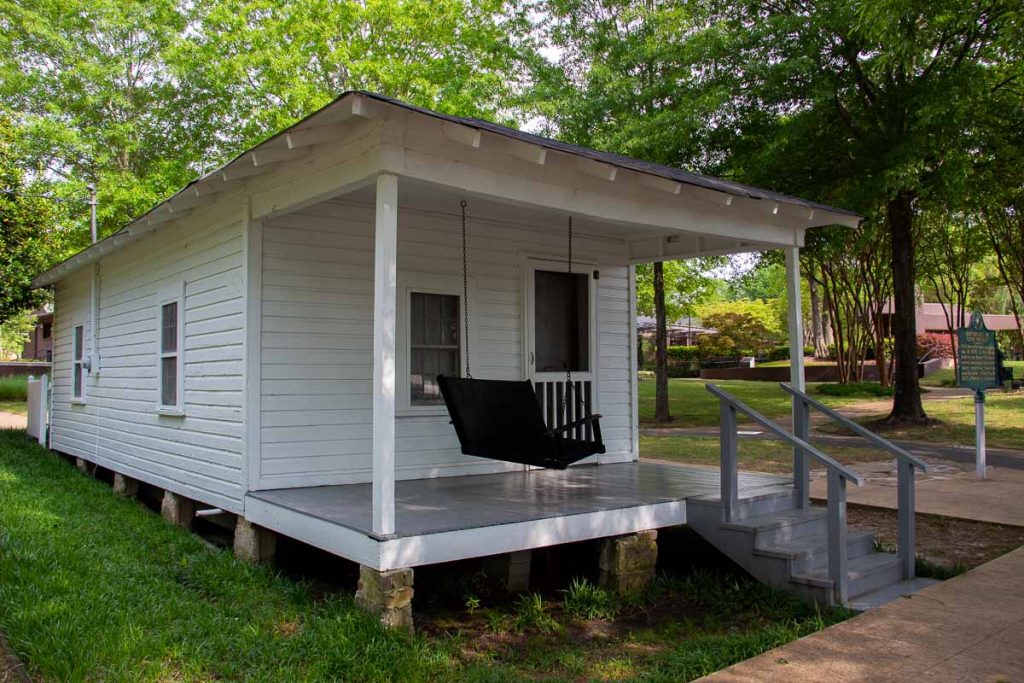
The “Elvis Birthplace Museum” is small, but full of lots of artifacts and stories – mostly about Elvis’ family and early life. (No photos are allowed inside.)
(Graceland also offers a day-trip from Memphis, if you just want to see Elvis’ home and prefer traveling with a group.)
At the Tupelo Hardware Company, you can hear the story of how Elvis bought his first guitar: He wanted a gun, but his mother wouldn’t allow it. I don’t think there’s a more poignantly American origin story than that.
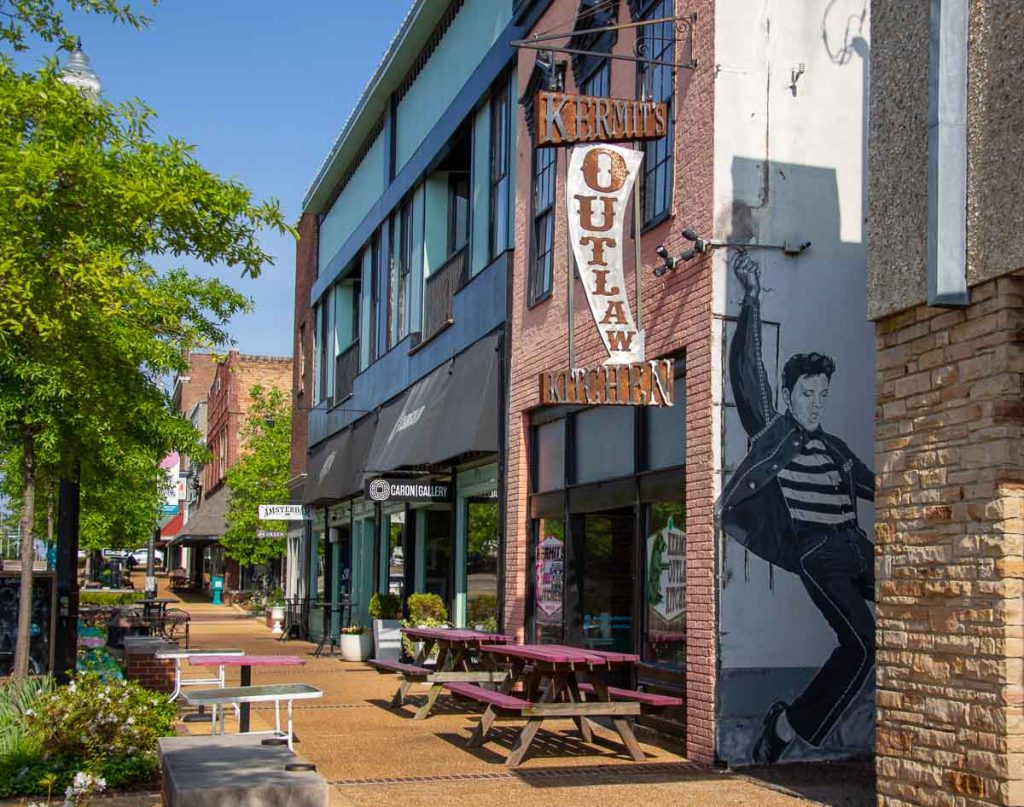
Tupelo, Mississippi, Hotels
We stayed at the Hotel Tupelo, which was freshly renovated (spring of 2022). They did a great job – it checks all the boxes for a modern design hotel, including a stylish bar downstairs, which seemed to be just about the only bar in the area that was open on a Tuesday night (and we looked).
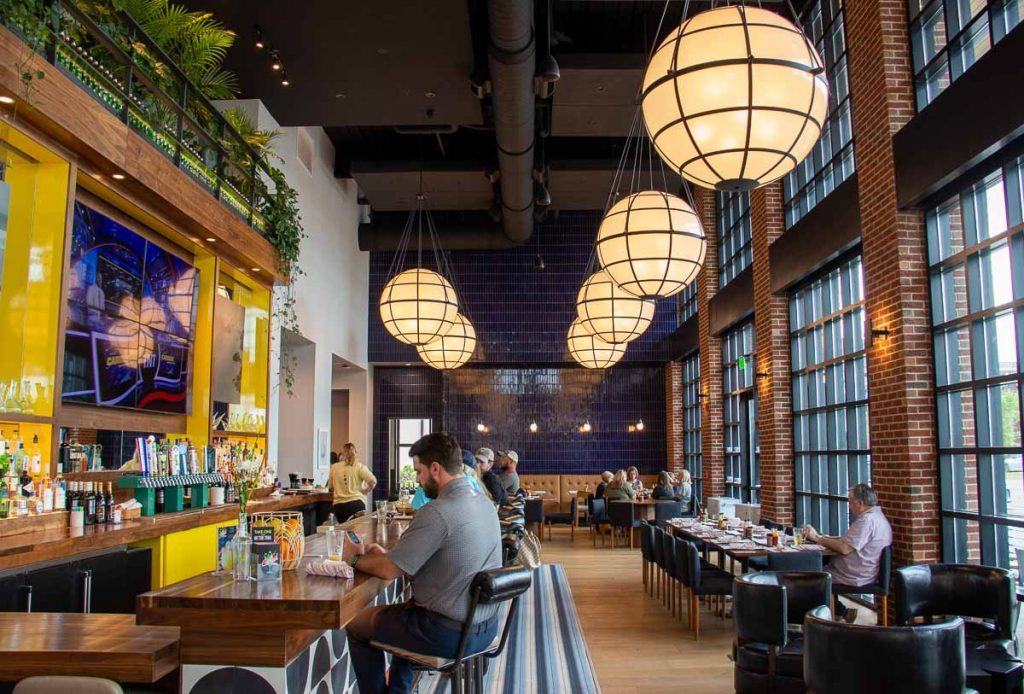
And while the Hotel Tupelo is a Wyndham property, it’s the closest thing to a locally owned hotel in town. (The franchise is owned by a Mississippi company and the management is local.)
It didn’t quite have that unique, hand-made vintage feel that I loved about the Travelers Hotel in Clarksdale, but it was still a very beautiful property.
However, the easy sustainability check marks I always look for in hotels were missing: The AC was set to 66 F in my room. The toiletries were the individual plastic kind.
So there’s room for the small improvements that would make this a stronger recommendation in my book. (And a new property, especially with corporate funding, should have no problem stepping up for these sustainability improvements.)
Sustainable Travel Tip:
I always call out these sustainability issues in reviews, and often in person – politely! – at the property to encourage change. And you can, too! It’s a great way to use your voice for more sustainable travel options.
Compare other Tupelo hotel rates on Booking.com.
Creative Southern Food in Tupelo
For dinner in Tupelo, we had an excellent “neo-soul” meal catered by Ethel Mae’s, a new local and Black-owned restaurant that just opened this spring. Chicken and waffles, collard greens, and homemade pickles made with unique peppers from West Africa. It was spectacular and fresh! I would definitely go back for more. In the kitchen is up-and-coming star chef Reggie Scott, so I expect this place to be a hit. (UPDATE: Unfortunately, this restaurant has closed as of spring 2024, according to their Facebook page.)
And the locally owned Queen’s Reward Meadery served up a tasting that highlighted the varied flavors that can be coaxed out of fermented honey.
(My favorite was the Orange Cranberry. It was on the semi-sweet side, but not syrupy-sweet by any means – and finding beverages in the South that were un-sweet enough for my tastes proved to be a challenge. It tasted bright, refreshing and like real fruit.)
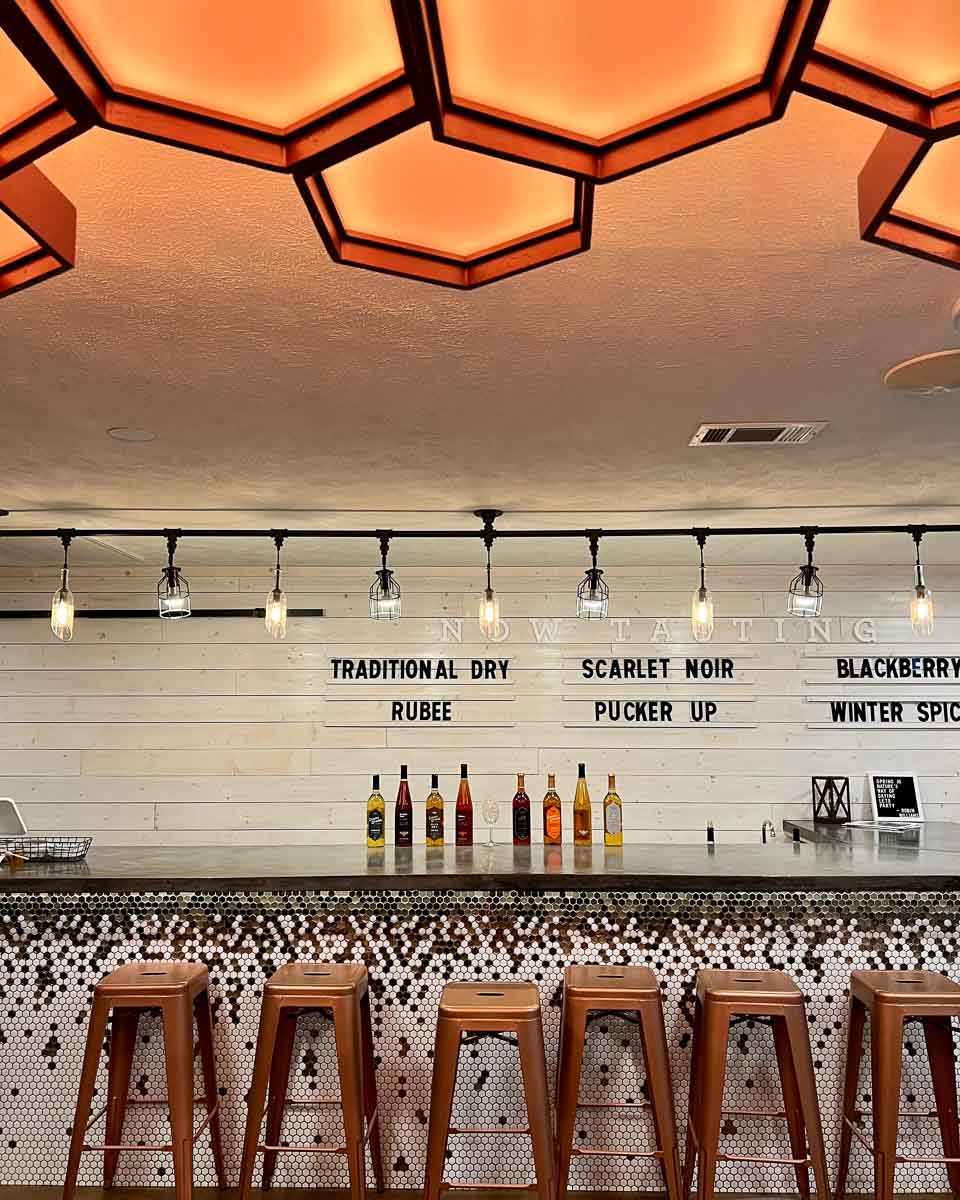
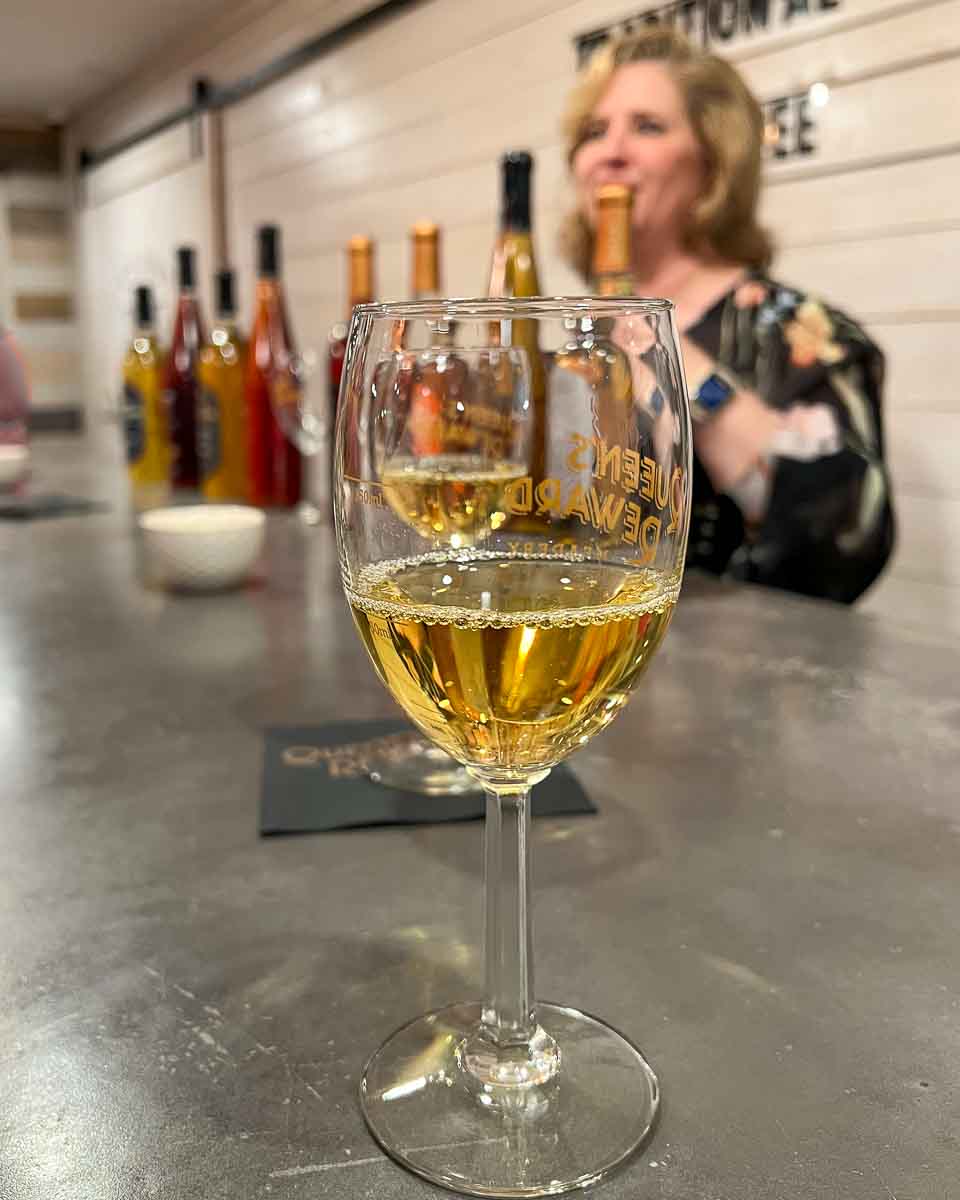
I hope you’ve enjoyed my favorite stops on the Mississippi Blues Trail! If you have questions, drop them in the comments below.
Travel Booking Resources for Your Trip:
For all of my favorite travel booking resources, see this page. Otherwise, here are the highlights:
Booking.com – where I book most of my hotels.
Kayak.com – Pretty much where I do all my flight research and a good place to start for rental cars, too.
Insure My Trip lots of options for travel insurance, which I’ve just recently learned is probably worth the money. They also have insurance for travelers coming to the US from abroad. (Please, please don’t come here without insurance. Our medical system will bankrupt you.)
This post is all about my favorite alternatives to AirBnb. (Sustainable, community-based, cheap or luxury, I’ve found great options for everyone here!)
Looking for more trip inspiration?
- The Adirondack mountains are one of my favorite destinations in North America – with lots of foodie spots and an interactive sustainability center.
- My guide to Napa Valley has everything you need to plan a sustainable wine-tasting trip!
- If you want to go a little further, don’t miss my intro guide to the Azores – Portuguese islands that are surprisingly easy to get to from North America. And when you start planning your trip, my detailed guide to Terceira island has everything you’ll need.
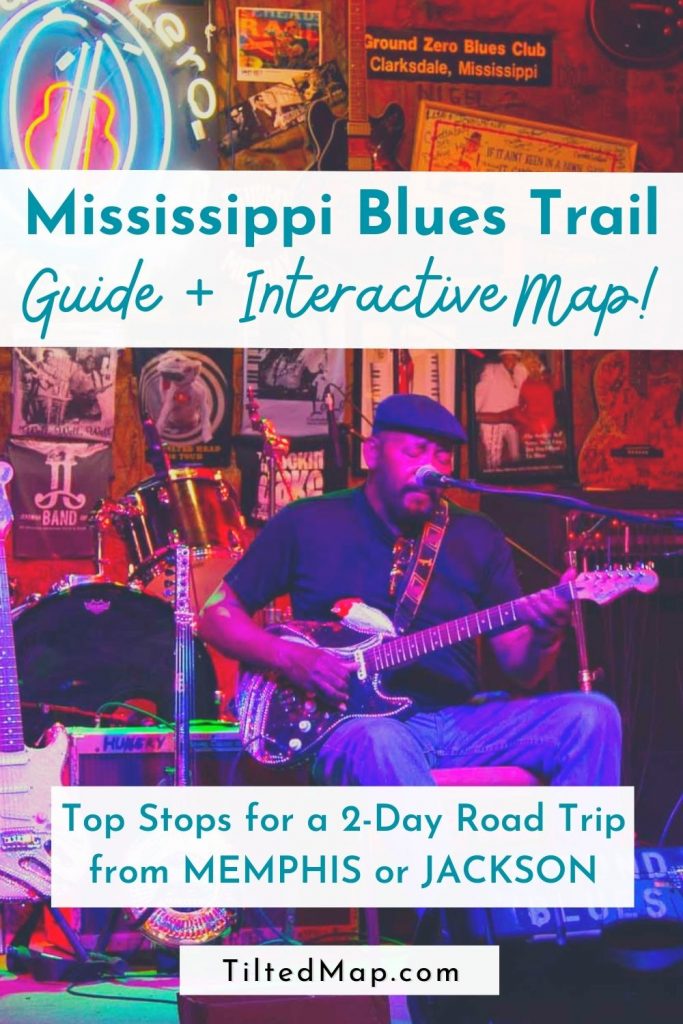

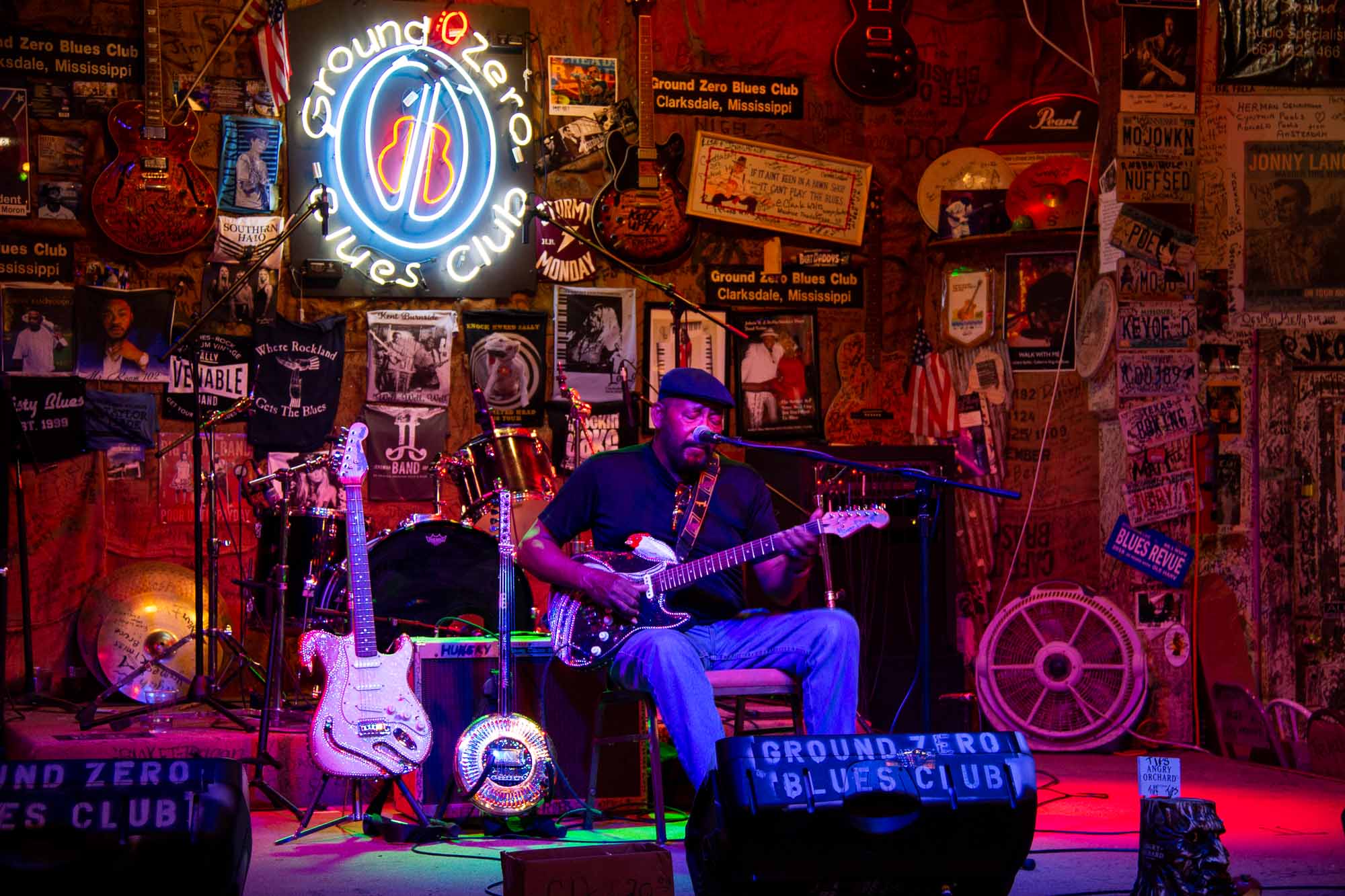
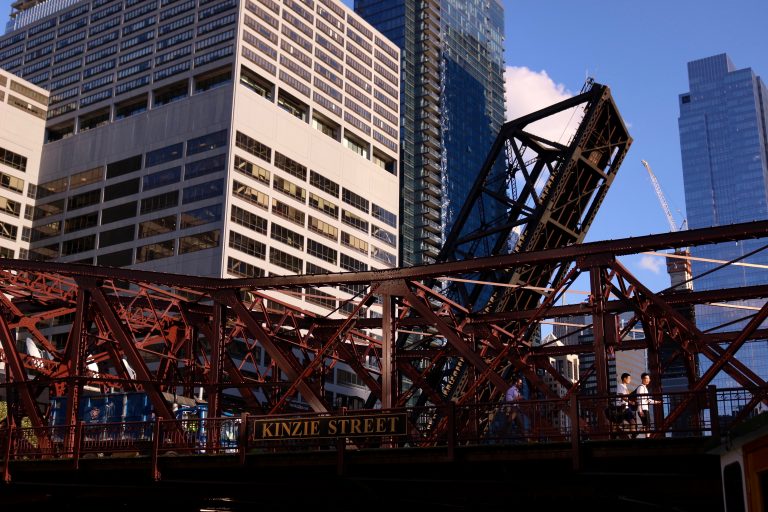
![Should You Buy Carbon Offsets for Your Travel or… Something Else? [Part 4]](https://www.tiltedmap.com/wp-content/uploads/2023/01/Flatey-Island-Iceland-no-trees-©KettiWilhelm2023-768x432.jpg)
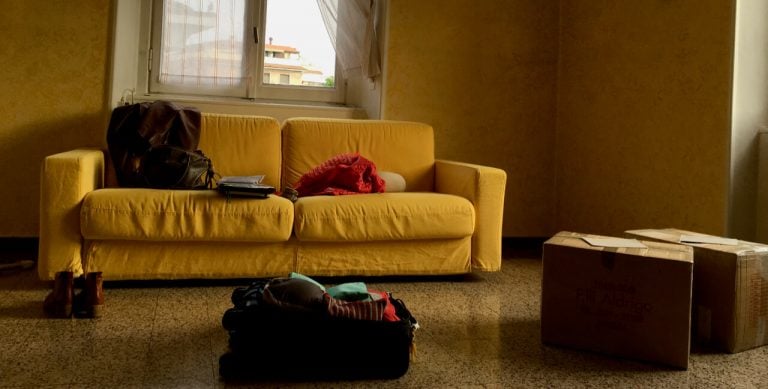
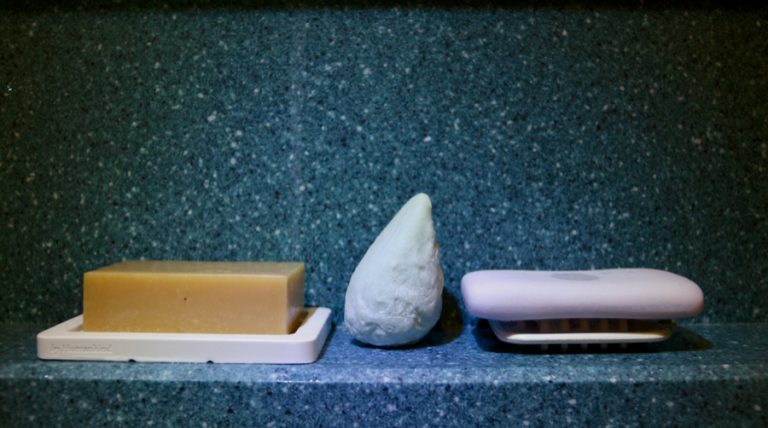
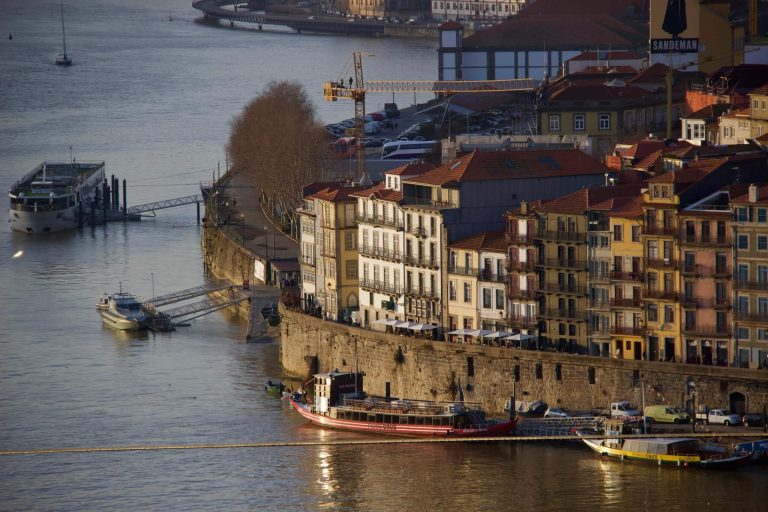
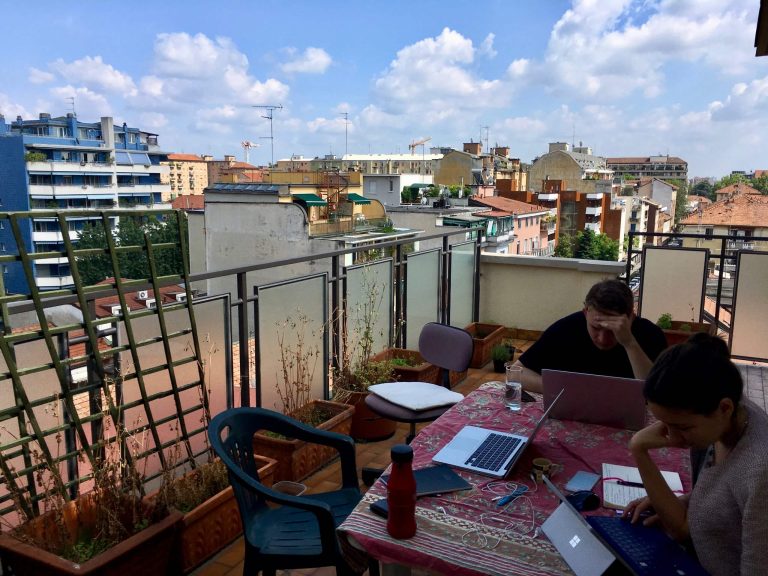
You’re welcome! 🙂
Thank you!
Love our
Again